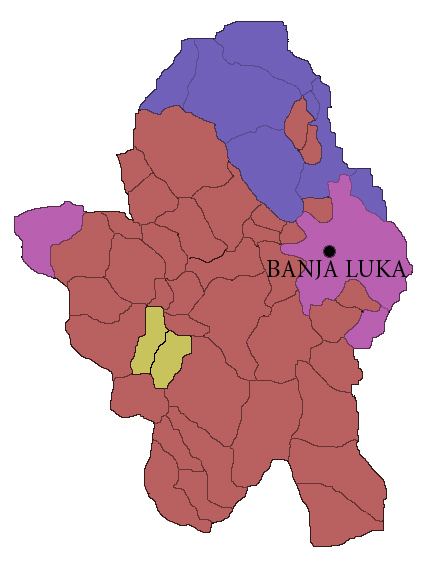 | ||
Current population
From 2013 census, The City of Banja Luka has a population of 185,042 people.
Contents
- Current population
- 1991
- 1981
- 1971
- Settlements over 1500 residents 1991 census
- Historical population
- References
1991
According to the 1991 census, the municipality of Banja Luka had a population of 195,692, including:
1981
According to the 1981. census, the municipality of Banja Luka had a population of 183,618, including:
1971
According to the 1971. census, the municipality of Banja Luka had a population of 158,736, including:
Settlements (over 1,500 residents), 1991. census
total: 143,079
total: 4,577
total: 3,798
total: 2,679
total: 2,578
total: 2,241
total: 2,009
total: 1,858
total: 1,703
total: 1,685
total: 1,522
total: 1,516
Historical population
At the first census, conducted by Austro-Hungarian authorities in 1879, Banja Luka had the following religious (ethnic) composition:
Banja Luka municipality - 86,209 citizens, Orthodox 74.46%, Muslims 14.33%, Catholics 10.52%
Banja Luka city - 13,566 citizens, Muslims 67.71%, 19.8% Orthodox.
As the city was industrialized and wider urbanization of the surrounding areas took place, Orthodox Serbs that typically inhabited surrounding rural areas (due to Ottoman feudal system) were incorporated into the city's urban structure. Bosnian Muslims claim that their drop of percentage in the city's population was partly influenced by the Agrarian Reform of 1918, which ordered major landowners to transfer land to those who tilled it, who in this region were mostly Orthodox Serbs. The Agrarian Reform was introduced as means to dismantle the old Bosnian feudal system. Bosnian Muslims claim that the reform was abused to change the ethnic makeup of the region in the long term. Bosnian Serbs claim that Agrarian Reform was introduced to return the land stolen from the Christian people by the Ottoman Empire. Because the city was in the center of the Bosnian Krajina region, with a predominant Orthodox Serb majority, the Serb population of Banja Luka has steadily increasing.
Banja Luka is the seat of the Roman Catholic Diocese of Banja Luka and home to the Cathedral of St. Bonaventure.
During World War II most of Banja Luka's prominent Serbian and Sephardic Jewish families were deported to nearby Croatian concentration camps, such as Jasenovac and Stara Gradiška in Croatia. Today, Banja Luka's Jewish community is virtually non-existent. A spike in Serbian immigration was mostly noted after the earthquake of 1969, when the city has seen a boom in housing construction.
In 1991 the city of Banja Luka was still an ethnically mixed city (with a relative Serb majority), while on the municipal level there was an evident Serb majority of 54.6%.
